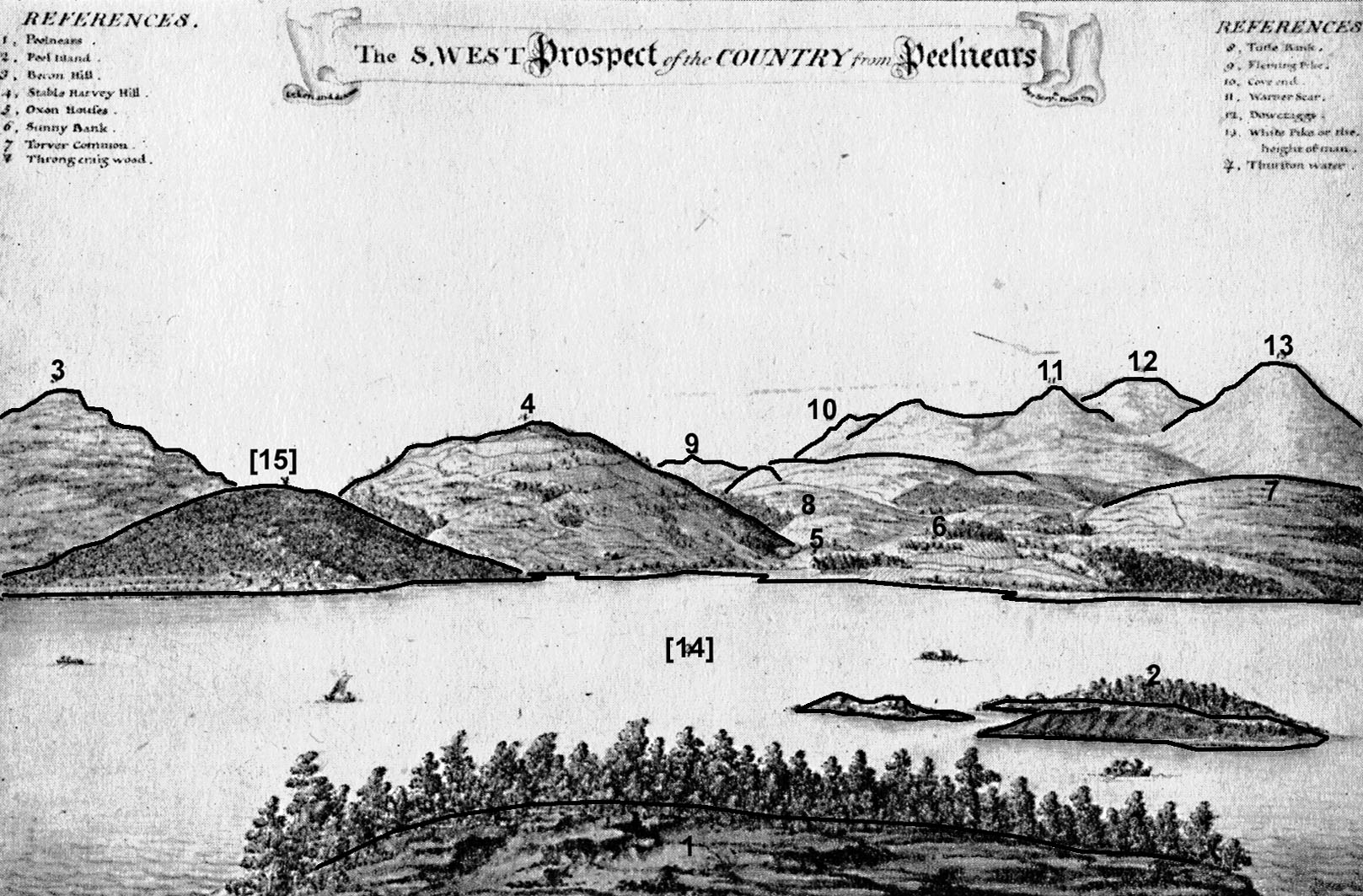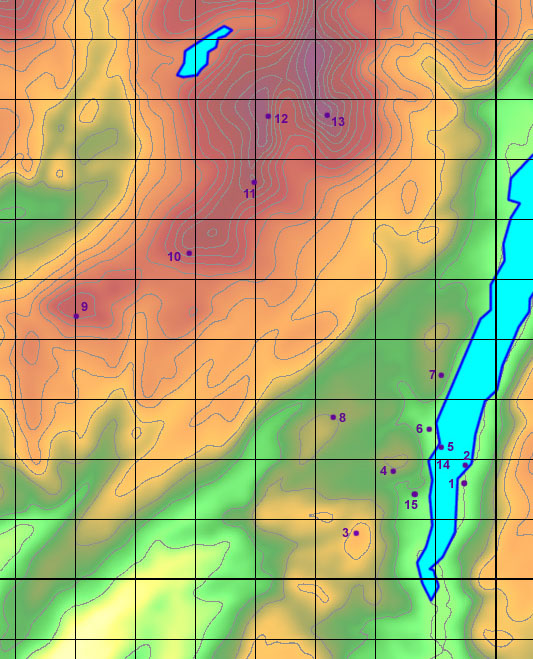
|

|
|
|
|

|
back to object record
|
|
|
|
|
|
Notes about Penn's SW Prospect across Coniston Water,
1732
|
|
|
These notes are about the watercolour painting, S West
Prospect of the Country from Peelnears, by Stephen Penn,
1732. The item has only been seen in photographic images; the painting
was believed to have been aquired by a Yale University collection - © private collection (204) - but it has not been traced there.
|
|
|

|
|
|
The painting is one of a series of four. Each scene has numbered features in the picture with a list of identifications, making them the precursors of 'outline views'. The place interpretations are ours.
|
|
|
Outline View
|
|
|

|
|
|
|
Objects in the View
|
|
|
The viewpoint is High Peel Near, a peninsula on the eastern
shore of the lake. The lake is Coniston Water. The direction
of the view is NW, not SW. Numbered objects in the view can
be identified today, the names a little different. The
identifications list name, civil parish and grid reference.
Numbers 14 and 15 are labelled with symbols that are not
awfully clear in the images I have to work with, so arabic
numerals have been allocated instead.
|
|
|
|
|
|
caption
|
Painted upper left and right:-
REFERENCES. / 1. Peelnears. / 2. Peel Island. / 3. Becon
Hill. / 4. Stable Harvey Hill. / 5. Oxen Houses. / 6. Sunny
Bank. / 7. Torver Common. / [ ] Throngcraig wood. / 8. Tutle
Bank. / 9. Fleming Pike. / 10. Cove end. / 11. Warner Scar.
/ 12. Dowcraggs. / 13. White Pike or height of man. / [ ]
Thur[i]ton Water.
|
|
|
|
|
|
1. Peelnears
|
High Peel Near, Colton, SD295917.
|
|
|
|
|
|
2. Peel Island
|
Peel Island, Colton, SD295918.
|
|
|
|
|
|
3. Becon Hill
|
Beacon, Blawith and Subberthwaite, SD27799068.
On Blawith Fells, called Beacon Fell by Wainwright.
|
|
|
|
|
|
4. Stable Harvey Hill
|
Coats Hill, Blawith and Subberthwaite, SD28459185.
Stable Harvey, building/s at SD28419170, lies on the
flank of this hill.
|
|
|
|
|
|
5. Oxen Houses
|
Oxen House, Blawith and Subberthwaite, SD290921.
|
|
|
|
|
|
6. Sunny Bank
|
Sunny Bank, Torver, SD289924.
|
|
|
|
|
|
7. Torver Common
|
Torver Back Common, Torver, SD291934 etc.
|
|
|
|
|
|
8. Tutle Bank
|
Anne Riggs, SD283927.
Notice that Tottle Bank is obscured by Coats Hill from
High Peel Nears from our low elevation.
|
|
|
|
|
|
9. Fleming Pike
|
Caw, Dunnerdale-with-Seathwaite, SD23049445. Caw is not
named Fleming Pike on any earlier map that we have seen, and
there is no pike of this name to be found.
|
|
|
|
|
|
10. Cove end
|
Probably White Pike, Dunnerdale-with-Seathwaite,
SD24899557.
There two places called Cove, large coombs not peaks,
north and north east of White Pike, and in the wrong place
with respect to Walna Scar from the Peel Nears
viewpoint.
|
|
|
|
|
|
11. Warner Scar
|
Brown Pike, Dunnerdale-with-Seathwaite, SD26069660
Walna Scar, Torver and Dunnerdale-with-Seathwaite,
SD256962 etc is the ridge to the left of the peak.
|
|
|
|
|
|
12. Dowcraggs
|
Dow Crag, Torver, SD26259778.
|
|
|
|
|
|
13. White Pike or the height of man
|
Old Man of Coniston. Coniston, SD27239782.
Not White Pike which is further south from the Peel Nears
viewpoint.
|
|
|
|
|
|
[14]. Thuriton Water
|
Coniston Water
Earlier called Thurston Water.
|
|
|
|
|
|
[15]. Throngcraig wood
|
Thrang Crag Wood, Blawith and Subberthwaite, SD288915
etc.
|
|
|
These places are located as:-
|
|
|

|
|
|
|
The View Today
|
|
|
There is no view from the highest part of Peel Near today,
tree planting now obscures the scene, except for glimpses
between the branches and leaves. It is possible to see a
whole view from the shore of the headland, but, to get any
comparison the photograph has vertical exageration about
170%. The view is from SD29499168, 13 August 2010.
|
|
|

|
|
|
Even standing on a rocky eminence close to the shore, the
view a little confused by bushes, the picture is not like
Stephen Penn's view. He has floated himself above the
headland to get a birds eye view of the scene, which alters
the relative heights of near and far objects. Being unable
to levitate we cannot check just what can and cannot be
seen. From elsewhere on the shore of the lake Caw is
visible, but not from Peel Near at a low elevation. We
wonder how much has been put in because his guide said 'over
there is ...' rather than 'what you see is ...'. Major
features like Beacon on Blawith Fells, Thrang Crag Wood, Old
Man of Coniston and other elements of that range are obvious
to the eye.
|
|
|
|
Topographical Drawings
|
|
|
The rest of this note is assembled from correspondence with John
Tullis, Nottingham University, 2010; and is the copyright of
various authors. .
|
|
|
Iolo Williams declares, Williams 1952 p.19:-
|
|
|
... With the possible exception of those by Thornhill, none
of the topographical drawings so far mentioned in this
chapter has been inspired by what we should nowadays
consider a love of beautiful scenery. Lakes, mountains,
picturesque cottages, even stretches of low-land river or
agricultural land, are absent, and the subjects have been
towns, great houses, ruins or other antiquities. The aim has
been intellectual rather than aesthetic. It was therefore
interesting when, a year or two ago, there turned up
unexpectedly a group of four large watercolours, three of
which depicted Lake District scenes, done in the thirties of
the eighteenth century. The artist was one Stephen Penn, of
whom nothing is known save what these drawings reveal. Take,
for example, his drawing The S. West Prospect of the Country
from Peelnears (13 1/8 x 19 1/4 inches), signed and dated
1732. It is a wide view over Coniston - or Thurston Water as
it was then called - outlined in pen and tinted in a rather
timid range of colour, chiefly pale greys, greens and blues,
with some pinky lights on the trees. In many ways it is
crude - the figures in the boats on the lake are wildly out
of proportion - and it is strictly topographical in that the
various hilltops and so on are numbered clearly in ink and
their names given in a table of reference. But the thing
that is really striking is that the artist (presumably an
amateur) had an eye for a picture, and that he has obviously
made this drawing as a record of a place which he loved to
look at. His impulse was aesthetic, and he has here been
moved by the beauty of a lake and mountain scene, long
before lakes and mountains were generally fashionable.
|
|
|
Peter Bicknell's opinion is, Bicknell 1947 p.9:-
|
|
|
... But mountains alone were not considered an adequate
subject for a picture. There are some early drawings of the
Lake District Fells by Stephen Penn. His prospect of the
country from Peelnears, dated 1732, shows the Coniston Fells
carefully delineated, coloured, numbered and named. But it
is a piece of pictorial cartography rather than a picture ;
and it was not till well after 1750 that mountain views
began to become popular ...
|
|
|
The painting is one of a series of four.
|
|
|
References
Williams, Iolo Aneurin: 1952: Early English Watercolours;
and some cognate drawings by artists born not later than
1785: Connoisseur (London)
Bicknell, Peter: 1947: British Hills and Mountains: Collins
(London)
Coombs, Katherine (curator, paintings, VandA, London): 2010:
correspondence with John Tullis
Tullis, John (Nottingham University): 2010: correspondence
|







 Penn 1730s
Penn 1730s